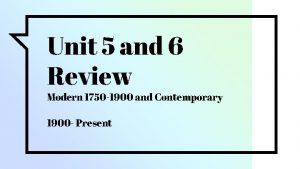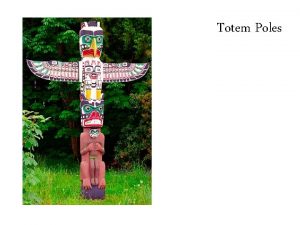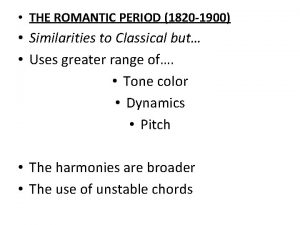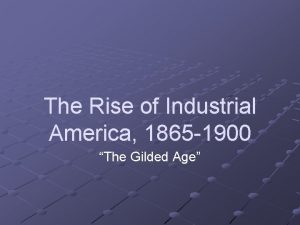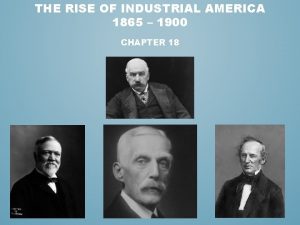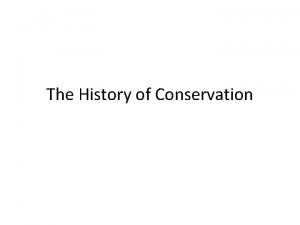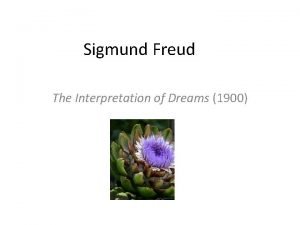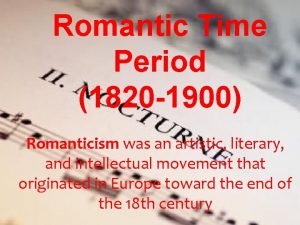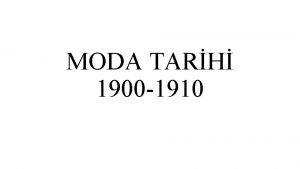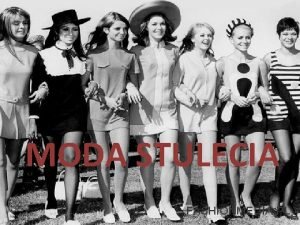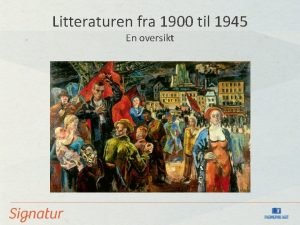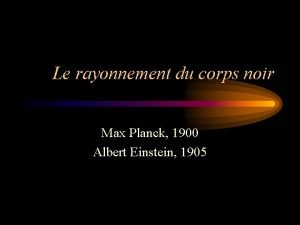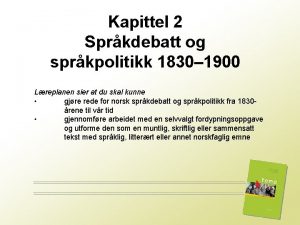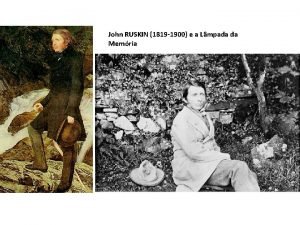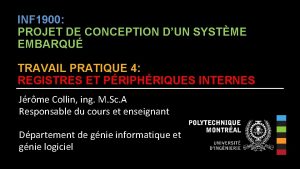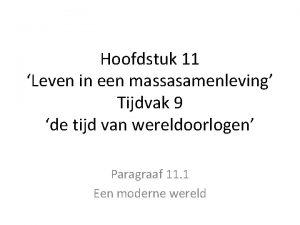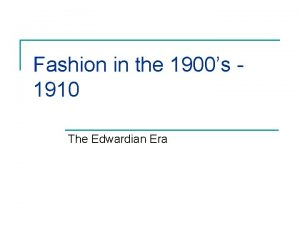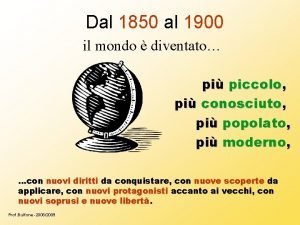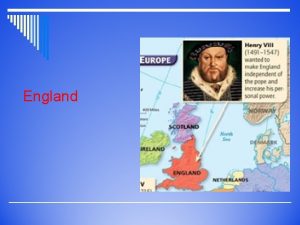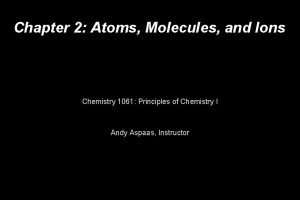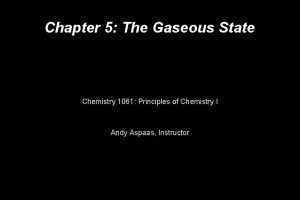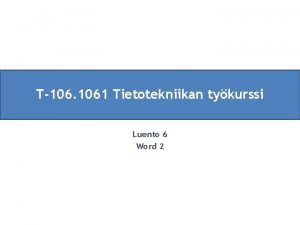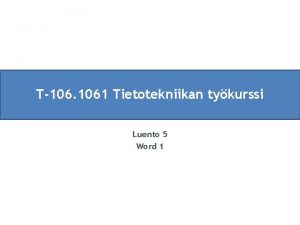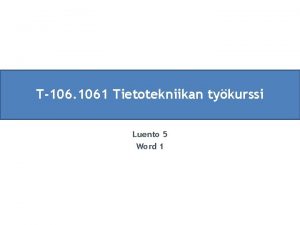England to 1900 English 1061 England 500 2015



























- Slides: 27

England to 1900 English 1061

England 500 -2015 Feudal economy (500 -1500) • Land is valuable. Population is rural. • Society is organized around kings, lords/knights, and peasants, by ties of loyalty Capitalist/Industrial economy (1500 -1968) • Production and goods are valuable. Population is urban. • Society is organized around owners and workers, by ties of economic benefit Knowledge economy (1968 -) • Information is valuable. Population is online. • Society is organized around multiple and temporary arrangements of sharing and controlling information

Early Modern England 1500 -1900 1517 Luther’s Ninety-Five theses 1519 -1522 Magellan circumnavigates the globe 1532 -1534 Henry VIII breaks with Rome 1618 -1648 Thirty Years’ war 1630 Puritans settle Boston 1633 Galileo’s trial 1642 -1649 English Civil war

Early Modern England 1500 -1900 II 1701 Tull invents the seed drill - start of Agricultural Revolution 1756 -63 Seven Years War (French and Indian War) 1765 Hargreaves invents the spinning jenny 1789 French Revolution 1825 First railroad in Britain 1832 Reform Bill 1848 Marx, Communist Manifesto 1848 England completes occupation of India

Key Developments 1. The economic development of industrial production through capitalism, as opposed to land production. The labor shortages of the 1300 s along with the growth of international trade brought new wealth and power into cities. Here also grew banking, investment, and new forms of business. The growth of the modern corporation or industry based on trade or mechanical production also became an important factor as new technologies in metallurgy, coal, oil, and electricity allowed goods to be produced in factories. All this caused a decline in the relative importance of land agriculture, and as well spelled the death of the old feudal system based on military or personal ties of loyalty. Royal courts fell in prestige when the real money was elsewhere.

Key Developments 2. The growth of international trade and colonization. Improved sea technology and better ships and navigation equipment allowed a huge expansion in markets and colonies as the European countries raced to claim foreign lands in North and South America and Africa and Asia. At times missionaries conflicted with speculators and investors, or new diseases decimated native populations, as these new lands became uneasily tied into the growing global system of capitalism and trade.

Key Developments 3. The expansion of industrialized war. Medieval war was actually infrequent and small-scale, not because its people were better but because war was incredibly expensive. New technologies drove the mechanization of modern, permanent armies and new, deadly weaponry such as cannons, rifles, warships, and machine guns. This made war far bloodier and easier to wage, especially as castles and armor became useless and civilian populations became drawn into war as targets.

Key Developments 4. The growth of nationalism, often in replacement or in competition to older religious traditions or folk traditions of identity. The growth of fixed countries based on language or land boundaries, as opposed to identity based on ethnic or other group markings, solidified Europe as fixed and competing countries as the Holy Roman Empire broke into permanent nations. The made early modern war particularly violent. On the plus side, nationalism often coincided and supported the progression toward state democracy and voting rights.

Key Developments 5. The growth of humanism and science. Originally the new renaissance philosophies from the lost Roman Empire and Greece were not hostile to Christianity and many early thinkers were also religious men. Over time the entire concept of truth as being revealed or reasoned out was in competition with the idea of empirical truth, information derived from direct observation or experimentation—the growth of modern science.

Key Developments 6. Religious war. As early modern Europe divided into countries, tensions with the central Roman Catholic Church grew, worsened by the corruption which had increased in an increasingly wealthy and powerful central church authority. Both for theological and political reasons, England Germany broke from the church and became Protestant, and Protestantism itself then splintered into sub-groups. Combined with the growth in nationalism and military technology, this caused a long series of wars between Protestant and Catholic nations. Fatigue from the religious wars was one element in the anti-religiosity of the secular French Revolution and the birth of socialism and Marxism.

The Victorian Era Queen Victoria (1837 -1901) was a popular queen and ruled at perhaps the height of the British Empire. The 19 th century was a time of territorial expansion and political and cultural dominance for England.

Victorian England 1837 -1901 …Unless you were poor. As public farm lands were closed off and people came to cities to find industrial jobs, living standards for the poor involved dangerous and insecure work at low wages, dirt, and poverty.

Victorian Values: Respectability!

Or not… The Victorian era has a stereotype of being prudish and sexually repressed, so much so that “Victorian” is now used as an adjective for this meaning. In fact, religious ideals of family respectability coexisted with confident, adult themes in art, photography, and literature.

Poetic Themes • Religious doubt and shock after Darwinian theory (Tennyson, Arnold) • Sensual, idealized imagery; religious and classical symbolism (Rosetti, Browning, Hopkins) • Poetry inspired by the ‘Pre-Raphaelite’ style of painting, which emphasized symbolic and idealized feeling over realism • Freer and looser poetic meter and lineation

Pre. Raphaelites

Pre. Raphaelites

Pre. Raphaelites


Victorian Timeline 1859: Charles Darwin publishes On the Origin of Species. 1867: Marx’s Das Kapitol is published. 1869: First Transcontinental Railroad completed in United States. 1879: Thomas Edison tests his first light bulb. 1890 s: Sigmund Freud first active in psychoanalysis. 1893: New Zealand becomes the first country to enact women's suffrage. 1903: First controlled heavier-than-air flight of the Wright Brothers. 1908: First commercial radio transmissions. The Ford Motor Company invents the Model T.

Victorian Ideas Political Economy was a methodology developed by early economists such as Adam Smith and Malthus which attempted to analyze, through mathematics and empirical evidence, the national relationships between production, consumption, and wealth creation. A predominant concept in this view was laissez-faires (leave it alone!)—that economies mostly worked best without interference from governments as it was in the natural interests of an industry to regulate itself for maximal profit and benefit. Romanticism was a movement in Europe around 1800 in opposition to what was seen as the growing cynicism and rationalism of the 1700 s after the religious wars and the seeming depersonalization and dehumanization of human beings in the age of factory production. Romanticism, in poet William Wordsworth’s words, involved “the spontaneous overflow of powerful feelings” and prioritized human emotion, childlike feeling, and strong passion. Emphasizing the beauty of nature and natural feelings, romanticism took a strong interest in art, literature, and music.

Fin de Siècle: “End of the age” At the end of the 19 th century, Queen Victoria was getting old, and writers and painters tired of Victorian conventions of respectability. • A time of fatigue with English society and the decadence of empire • Increasingly shocking depictions of love and sexuality • Cynicism mixed with optimism for the new century

Fin de Siècle: “End of the age” Strongly influenced by French culture, late Victorian intellectual activity was often marked by “stylish” cynicism and by disenchantment with the failure of democracy to spread wealth and benefits evenly from rich to poor. • Growing popularity of socialist movements • An intellectual movement of existentialism and depression

Oscar Wilde – The Importance of Being Earnest (1895) Algernon: I hope tomorrow will be a fine day, Lane: It never is, sir. Algernon: Lane, you're a perfect pessimist. Lane: I do my best to give satisfaction, sir.

Fin de Siècle: “End of the age” At the same time, the growth of industrialism in Europe created a dangerous balance of powers between newly wealthy Germany and Prussia and England France.

Storm Clouds 1. The decline in belief of man as divinely special. Darwin wasn’t an atheist until late in life, and he believed that evolutionary theory wasn’t necessarily in conflict with Christianity—many European churches believed that the Genesis story of creation wasn’t meant literally anyway. But as evolutionary theory and the scientific process became more hostile to traditional concepts of man as created by God and having a special identity, the picture of man as having a higher moral spirit is challenged.

Storm Clouds 2. The decline of belief in man as rational. Freud’s studies begin to suggest that people’s mental states are unreliable and subject to neuroses. Bergson writes on the perception of time as unstable and subjective. John Watson studies behaviorism, suggesting that people can be conditioned into different behaviors. Werner Heisenberg’s Uncertainty Principle (1928) argues that matter itself is unpredictable.
 Nfpa 1061 certifications
Nfpa 1061 certifications 3500/500
3500/500 2015 dse english reading
2015 dse english reading 2015 english exam
2015 english exam 1750-1900 portfolio map
1750-1900 portfolio map What is a totem
What is a totem Characteristics of romantic period
Characteristics of romantic period The rise of industrial america 1865-1900
The rise of industrial america 1865-1900 The rise of industrial america 1865-1900
The rise of industrial america 1865-1900 Lacey act 1900
Lacey act 1900 The interpretation of dreams 1900
The interpretation of dreams 1900 Shridhar steels pvt ltd
Shridhar steels pvt ltd 1820-1900
1820-1900 Revolutionary leaders 1900-1939
Revolutionary leaders 1900-1939 1997-1910
1997-1910 Kapcie emu 1900
Kapcie emu 1900 Moda 1900 a 1920
Moda 1900 a 1920 Litteraturen 1900 til 1945
Litteraturen 1900 til 1945 Literatur der jahrhundertwende autoren
Literatur der jahrhundertwende autoren 1900 max planck
1900 max planck Språkdebatten 1900
Språkdebatten 1900 Resssucitar
Resssucitar Inf1900
Inf1900 Moderne massasamenleving
Moderne massasamenleving 1900s girls fashion
1900s girls fashion 1900 to 1910 fashion
1900 to 1910 fashion Kristallpalast london bauzeit
Kristallpalast london bauzeit Scoperte scientifiche dal 1850 al 1900
Scoperte scientifiche dal 1850 al 1900




